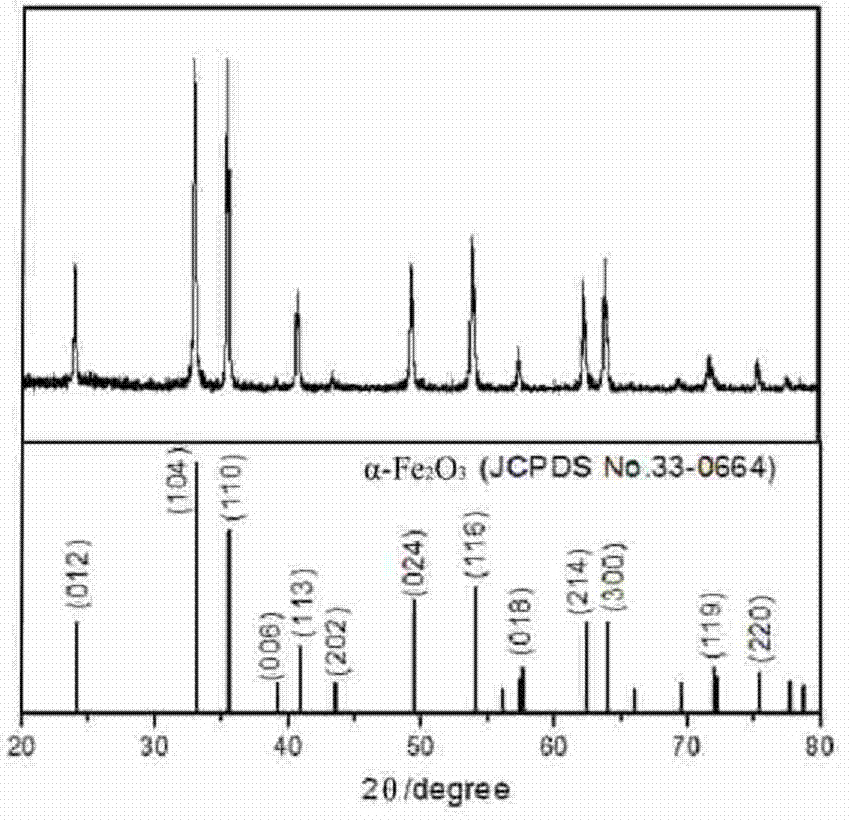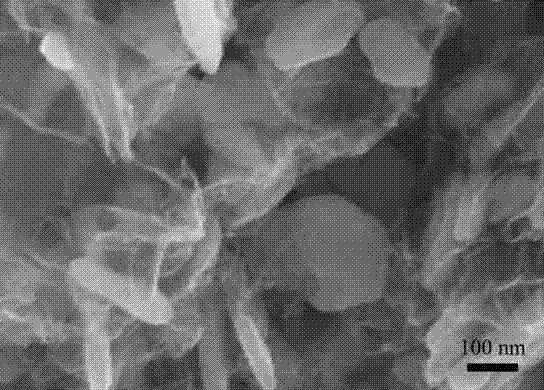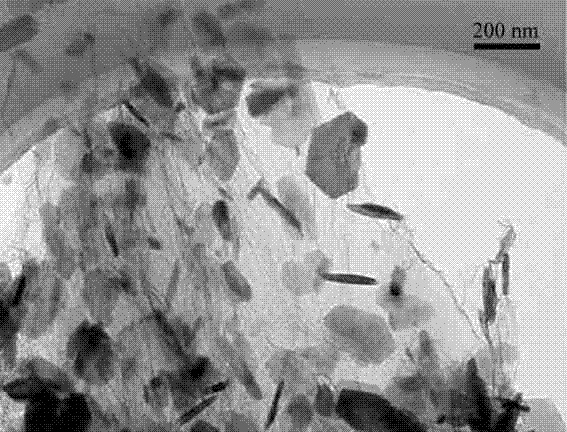A preparing method of a nanometer Fe2O3/rGO composite material and applications of the composite material
A composite material, fe2o3 technology, applied in nanotechnology, nanotechnology, nanotechnology for materials and surface science, etc., can solve the problems of poor conductivity, poor lithium-ion battery effect, poor volume expansion coefficient, etc. The effect of stable product quality, uniform appearance and low cost
- Summary
- Abstract
- Description
- Claims
- Application Information
AI Technical Summary
Problems solved by technology
Method used
Image
Examples
Embodiment 1
[0035] a) Add 1.1g FeSO 4 ·7H 2 O is dissolved in the mixed liquid of 80ml water and 20ml glycerol to form mixed solution A;
[0036] b) Disperse 0.04 graphite oxide in 40ml of water and ultrasonically disperse for 2 hours to form solution B;
[0037] c) Add solution B to mixed solution A, and stir to form mixed solution C;
[0038] d) Put the mixed solution C into an autoclave, place the autoclave at a temperature of 180°C for 10 hours to obtain the product;
[0039] e) The product was washed several times with absolute ethanol and water, and dried in a vacuum oven at 70°C for several hours to obtain the nano-Fe 2 o 3 / rGO composites.
[0040] The product was identified as α-Fe by X-ray powder diffraction 2 o 3 , powder X-ray diffraction results as figure 1 shown; material morphology by scanning electron microscope, transmission electron microscope as figure 2 , shown in 3, it can be seen from the figure that the nanosheet α-Fe 2 o 3 uniformly embedded in graphene...
Embodiment 2
[0043] a) Add 1.1g FeSO 4 ·7H 2 O is dissolved in the mixed liquid of 70ml water and 20ml glycerol to form mixed solution A;
[0044] b) Disperse 0.04 graphite oxide in 40ml of water and ultrasonically disperse for 2 hours to form solution B;
[0045] c) Add solution B to mixed solution A, and stir to form mixed solution C;
[0046] d) Put the mixed solution C into an autoclave, place the autoclave at a temperature of 140° C. and react for 10 hours to obtain the product;
[0047] e) The product was washed several times with absolute ethanol and water, and dried in a vacuum oven at 70°C for several hours to obtain the nano-Fe 2 o 3 / rGO composites.
[0048] The resulting product was subjected to X-ray powder diffraction as figure 1 Similarly, the material morphology by scanning electron microscopy such as Figure 4 As shown, it can be seen from the figure that the nanosheet-like α-Fe 2 o 3 uniformly embedded in graphene.
Embodiment 3
[0050] a) Add 1.1g FeSO 4 ·7H 2 O is dissolved in the mixed liquid of 80ml water and 20ml glycerol to form mixed solution A;
[0051] b) Disperse 0.04 graphite oxide in 40ml water and ultrasonically disperse for 2.5h to form solution B;
[0052] c) Add solution B to mixed solution A, and stir to form mixed solution C;
[0053]d) Put the mixed solution C into an autoclave, place the autoclave at a temperature of 150° C. to react for 12 hours to obtain the product;
[0054] e) The product was washed several times with absolute ethanol and water, and dried in a vacuum oven at 60°C for several hours to obtain the nano-Fe 2 o 3 / rGO composites.
[0055] The resulting product is identified through X-ray powder diffraction and scanning electron microscopy (with the nano-Fe prepared in Example 1 2 o 3 / rGO composite material) it can be seen that it is nano-Fe 2 o 3 / rGO composites.
PUM
| Property | Measurement | Unit |
|---|---|---|
| Concentration | aaaaa | aaaaa |
| Concentration | aaaaa | aaaaa |
Abstract
Description
Claims
Application Information
 Login to View More
Login to View More - R&D
- Intellectual Property
- Life Sciences
- Materials
- Tech Scout
- Unparalleled Data Quality
- Higher Quality Content
- 60% Fewer Hallucinations
Browse by: Latest US Patents, China's latest patents, Technical Efficacy Thesaurus, Application Domain, Technology Topic, Popular Technical Reports.
© 2025 PatSnap. All rights reserved.Legal|Privacy policy|Modern Slavery Act Transparency Statement|Sitemap|About US| Contact US: help@patsnap.com



